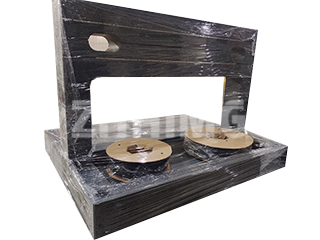In the world of mold manufacturing, accuracy is not a virtue—it is a non-negotiable prerequisite. A micron of error in a mold cavity translates to thousands of defective parts, making the process of verifying geometric precision critical. The precision granite platform, supplied by manufacturers like ZHONGHUI Group (ZHHIMG®), serves as the essential, immutable reference plane that underpins two core functions of mold making: Accuracy Detection and Benchmark Positioning.
1. Accuracy Detection: Validating the Mold’s Geometry
The primary role of granite in mold shops is to act as the ultimate, reliable reference surface against which the complex geometries of mold components are measured. Molds, whether for injection, casting, or stamping, are defined by their flatness, parallelism, squareness, and intricate dimensional features.
- Flatness Verification: Granite provides a verifiable, near-perfect flat plane, crucial for checking the contact surfaces of mold bases, core plates, and cavity blocks. Using instruments like height gauges, dial indicators, and electronic levels on a granite surface plate allows toolmakers to instantly detect warpage or deviation from the design specifications. The superior stiffness and dimensional stability of high-density black granite, such as ZHHIMG®’s material, ensure the platform itself will not flex or thermally distort, guaranteeing the measurement is accurate to the component, not the base.
- Coordinate Measuring Machine (CMM) Foundation: Modern mold inspection relies heavily on CMMs, which perform rapid, multi-axis dimensional checks. Granite’s role here is foundational: it is the material of choice for the CMM’s base and rails. Its excellent vibration damping and low thermal expansion coefficient ensure that the movement of the CMM probe remains true, providing repeatable, reliable data necessary for accepting or correcting a high-value mold.
2. Benchmark Positioning: Establishing Critical Alignment
Beyond passive inspection, granite plays an active role in the assembly and alignment phases of mold construction. Every mold requires internal components—cores, inserts, ejector pins—to be positioned with extremely tight tolerances to ensure proper fit, functionality, and longevity.
- Tooling Layout and Assembly: The granite platform serves as the master benchmark plane during the initial layout and final assembly. Toolmakers use the flat surface to mark out features, align bushings, and verify the perpendicularity and parallelism of all mechanical actions. Any error introduced at this stage would be locked into the mold, leading to flash, misalignment, or premature wear.
- Modular Fixturing: For complex, multi-cavity molds, the granite platform is often customized with embedded threaded steel inserts or T-slots. This allows for the precise, repeatable clamping and positioning of mold components during grinding, wiring, or maintenance, ensuring that the working surface remains the singular, reliable point of reference for all subsequent work.
The precision granite platform is thus not merely a piece of shop equipment; it is a strategic investment in quality assurance. It ensures that the millions of cycles a mold will perform are built upon a foundation of verifiable accuracy, reducing iteration time, preventing costly material waste, and safeguarding the final quality of mass-produced components across the automotive, consumer electronics, and medical sectors.
Post time: Oct-22-2025

